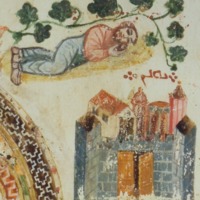Onnik Kiremitlian - Profile on Academia.edu (original) (raw)

Related Authors
Università Cattolica del Sacro Cuore (Catholic University of the Sacred Heart)
Uploads
Papers by Onnik Kiremitlian
The corpus of Armenian texts attributed to Marutha of Tagrit
In the Armenian manuscript tradition exists a sizeable amount of scattered texts that are ascribe... more In the Armenian manuscript tradition exists a sizeable amount of scattered texts that are ascribed to a certain Marutha, unidentified whether he is Marutha of Martyropolis (4th-5th cc.) or Marutha of Tagrit (7th c.). To date no serious scholarly research was undertaken to authenticate the authorship of these texts, conclusively ascertain which of them belong to Marutha of Tagrit, and distinguish the spurious ones from those wrongly ascribed to Marutha. Thus the aim of the present thesis is to establish a corpus of Armenian texts that would certainly and verifiably belong to the pen of Marutha of Tagrit, and present a critical and translated edition of his works. Among the works attributed to Marutha of Tagrit in the Armenian manuscript tradition we have only the Homily on the New Sunday with its complete Syriac original, and except for few fragments in Garshuni Arabic, all the other texts that are verifiably from the pen of Marutha of Tagrit are not attested in Syriac manuscripts, a...
St. Ephrem is a representative of a branch of Christianity that is neither Eastern Byzantine Orth... more St. Ephrem is a representative of a branch of Christianity that is neither Eastern Byzantine Orthodox nor Western Roman Catholic. In fact he comes from a tradition which is completely different from both of these above. He represents an Aramaic culture, which is a totally different mainstream branch of Christianity. This uniquely Aramaic Christianity is deeply rooted in Semitic culture and is genuinely biblical. In the Aramaic milieu, Christianity was directly introduced by the apostles and Jewish evangelizers. As such, in his writings, we find the direct influence or the echoes of such a tradition. That is the reason why this form of Christianity should be studied on equal footing with the other mainstream Christian traditions. One of its foremost and original representatives is Ephrem.
The corpus of Armenian texts attributed to Marutha of Tagrit
In the Armenian manuscript tradition exists a sizeable amount of scattered texts that are ascribe... more In the Armenian manuscript tradition exists a sizeable amount of scattered texts that are ascribed to a certain Marutha, unidentified whether he is Marutha of Martyropolis (4th-5th cc.) or Marutha of Tagrit (7th c.). To date no serious scholarly research was undertaken to authenticate the authorship of these texts, conclusively ascertain which of them belong to Marutha of Tagrit, and distinguish the spurious ones from those wrongly ascribed to Marutha. Thus the aim of the present thesis is to establish a corpus of Armenian texts that would certainly and verifiably belong to the pen of Marutha of Tagrit, and present a critical and translated edition of his works. Among the works attributed to Marutha of Tagrit in the Armenian manuscript tradition we have only the Homily on the New Sunday with its complete Syriac original, and except for few fragments in Garshuni Arabic, all the other texts that are verifiably from the pen of Marutha of Tagrit are not attested in Syriac manuscripts, a...
St. Ephrem is a representative of a branch of Christianity that is neither Eastern Byzantine Orth... more St. Ephrem is a representative of a branch of Christianity that is neither Eastern Byzantine Orthodox nor Western Roman Catholic. In fact he comes from a tradition which is completely different from both of these above. He represents an Aramaic culture, which is a totally different mainstream branch of Christianity. This uniquely Aramaic Christianity is deeply rooted in Semitic culture and is genuinely biblical. In the Aramaic milieu, Christianity was directly introduced by the apostles and Jewish evangelizers. As such, in his writings, we find the direct influence or the echoes of such a tradition. That is the reason why this form of Christianity should be studied on equal footing with the other mainstream Christian traditions. One of its foremost and original representatives is Ephrem.















